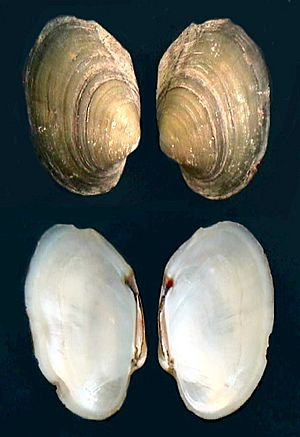Anodontites facts for kids
Quick facts for kids Anodontites |
|
|---|---|
 |
|
| Anodontites trapesialis | |
| Scientific classification |
|
| Kingdom: | Animalia |
| Phylum: | Mollusca |
| Class: | Bivalvia |
| Order: | Unionida |
| Family: | Mycetopodidae |
| Subfamily: | Anodontitinae |
| Genus: | Anodontites Bruguière 1792 |
| Species | |
Anodontites is a group of freshwater mussels. These are aquatic bivalve mollusks, which means they are soft-bodied animals with two shells. They belong to the family Mycetopodidae.
You can find Anodontites mussels in South and Middle America. Their range goes as far north as Mexico.
Contents
About Anodontites Mussels
Anodontites mussels are an interesting type of shellfish. They live in freshwater environments like rivers and lakes. Like other mussels, they have two shells that protect their soft bodies.
These mussels play an important role in their ecosystems. They help filter water, which keeps their habitats clean.
Where Do They Live?
Anodontites mussels are native to the Americas. They are found across a wide area. This includes many countries in South America. They also live in parts of Central America and Mexico.
Different species of Anodontites live in various specific locations. For example, some are found in the Amazon Basin. Others live in the Paraná River system.
Types of Anodontites
There are many different kinds of Anodontites mussels. Scientists have identified several species. Each species has its own unique features. They might differ in size, shape, or where they prefer to live.
Some well-known species include Anodontites crispata and Anodontites trapesialis. These are found in many parts of tropical South America. Other species might only live in a small area. For example, Anodontites colombiensis is known from rivers in northern Colombia.
Anodontites from the Past
Scientists have also found Anodontites from long ago. These are called fossils. Fossils help us learn about ancient life. They show us how these mussels have changed over millions of years.
Some fossil species are no longer alive today. For example, Anodontites batesi is known only from fossils found in Peru. The oldest Anodontites fossils date back to the Late Cretaceous period. This was about 70 million years ago!
See also
 In Spanish: Anodontites para niños
In Spanish: Anodontites para niños

